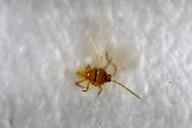
San Jose scale (male)
Identification tip: Adult male San Jose scales have
well developed legs, a single pair of wings, long antennae,
and a thin brown band across the thorax. This male is caught
in a pheromone trap. |
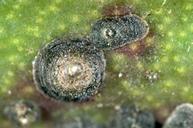
San Jose scale (mature female)
Identification tip: Mature female San Jose scale is
covered by a grayish, flattened, circular shell, about 0.125
inch diameter, with a distinct nipple (center). The immature
male (above female) is elongate. |

San Jose scale crawlers
Identification tip: San Jose scale crawlers are bright
yellow and tiny (about the size of the sharp end of a pin),
with well-developed eyes, antennae, and legs. |
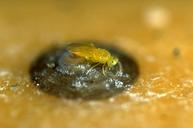
Aphytis aonidiae
Identification tip: Adult Aphytis aonidiae,
a parasite of San Jose scale, is a tiny yellow wasp with
short antennae and fringed wings. Shown here laying an egg
in a scale. |
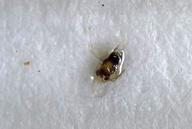
Encarsia perniciosi
Identification tip: Scale parasite, Encarsia perniciosi,
caught in pheromone trap used to monitor flights of male
San Jose scale. It is a tiny, dark wasp with short stubby
antennae. |
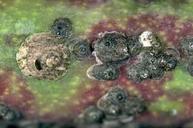
San Jose scale (parasitized)
Identification tip: The exit hole in the covering
of the scale (left) indicates that a parasite has emerged. |


